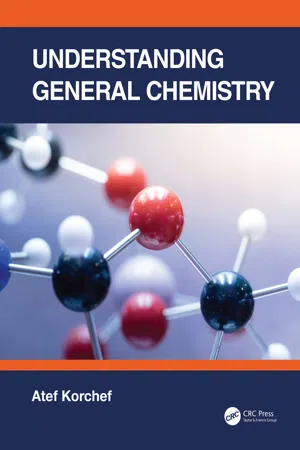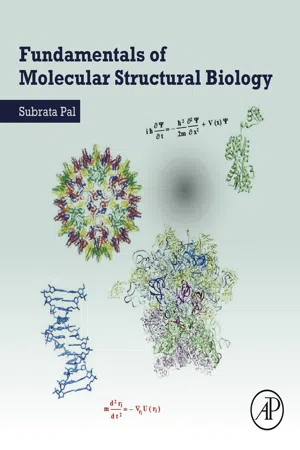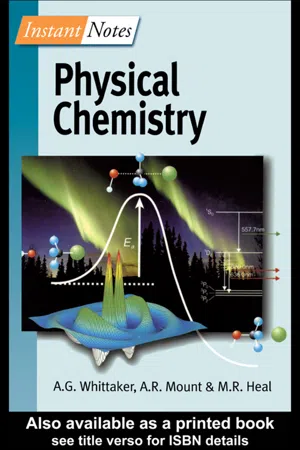Chemistry
Examples of Covalent Bonding
Covalent bonding occurs when atoms share electrons to achieve a stable electron configuration. Examples of covalent bonding include the diatomic molecules of hydrogen (H2), oxygen (O2), and nitrogen (N2), where two atoms of the same element share electrons to form a stable molecule. Additionally, molecules like water (H2O) and methane (CH4) also exhibit covalent bonding between different elements.
Written by Perlego with AI-assistance
8 Key excerpts on "Examples of Covalent Bonding"
Learn about this page
Index pages curate the most relevant extracts from our library of academic textbooks. They’ve been created using an in-house natural language model (NLM), each adding context and meaning to key research topics.
- eBook - ePub
- Atef Korchef(Author)
- 2022(Publication Date)
- CRC Press(Publisher)
The electrons involved in bonding are usually those in the outermost (valence) shell. There are three types of chemical bonds:- A covalent bond results from sharing electrons between the atoms. The covalent bond is usually found between non-metals. The covalent bond can be polar or non-polar.
- Examples of molecules showing polar covalent bonds: HCl, HBr and H2 O
- Examples of molecules showing non-polar covalent bonds: Homonuclear diatomic molecules such as I2 , Br2 , Cl2 , O2 and F2 , and hydrocarbons (Cn H2n + 2 ). A non-polar covalent bond in I2 and a polar covalent bond in HCl.
- An ionic bond results from the transfer of electrons from a metal to a non-metal.
- Example: The bond between sodium (Na) and chlorine (Cl) in NaCl is an ionic bond. The NaCl compound obtained is an ionic compound.
- A metallic bond is formed between positively charged atoms in which the free electrons are shared among a structure of positively charged ions. Metallic bonding is the main type of chemical bond that forms between metal atoms.
Lewis dot representation or electron dot diagram is a simplistic way of showing the valence electrons of an atom that uses dots around the chemical symbol of the element with no more than two dots on a side. To represent the Lewis dot diagram of an atom, carry out the following steps:- Write out the electronic configuration of the atom or the ion.
- Find the number of valence electrons.
- Draw the valence electrons as dots around the chemical symbol of the atom or the ion.
- Example: The seven valence electrons of Cl are drawn in the following configuration:
- Example: 7 N and 15 P belong to the same group (Group 15) and have similar Lewis dot diagrams:
Electron dot diagrams for ions are like those of atoms, except that some electrons have been removed from or added to a neutral atom to obtain an ion. Conventionally, when we draw electron dot diagrams for ions, we show the original valence shell of the atom and not the valence shell of the ion. - eBook - ePub
- Tony Cox(Author)
- 2004(Publication Date)
- Taylor & Francis(Publisher)
Topic C1 ).• When one atom is very electropositive and the other very electronegative, a solid compound is formed that is often regarded as ionic. In this picture there is a complete transfer of one or more electrons, giving cations of the electro-positive element and anions of the electronegative one, which are then held together by electrostatic attraction (see Topics D3 , D4 and D6 ). Solids are formed rather than molecules because the force is not directional, and greatest stability is achieved by packing several anions around each cation and vice versa.Fig. 2. The bonding triangle, showing a selection of elements and compounds plotted against the Pauling electronegativities. Bond polarityA covalent bond between two atoms of the same element is described as homopolar, one between different elements as heteropolar; the general term bond polarity describes the unequal sharing of electrons between two atoms, and is a feature of heteropolar bonds when the two elements concerned have a different electro-negativity. The more electronegative atom draws electrons and thus acquires a partial negative charge, with the other atom becoming correspondingly positive. One manifestation of such polarity is the formation of an electric dipole moment, the magnitude of which is equal to the product of the charges and their average separation. The dipole moments decrease in a series of molecules such as HF > HCl > HBr > HI as might be expected from the falling difference in electronegativities. Dipole moments are, however, not always easy to interpret, as they can be influenced by other factors, such as the relative orientation of bonds in polyatomic molecules and the distribution of nonbonding electrons. Dipole moments are an important source of intermolecular forces (see Topic C10 - eBook - ePub
- Jeffrey Gaffney, Nancy Marley(Authors)
- 2017(Publication Date)
- Elsevier(Publisher)
Chapter 3Chemical Bonding—The Formation of Materials
Abstract
This chapter covers chemical bonding between atoms and ions and how this affects the chemical properties of the elements. Which elements form ions and the typical charges on the ions are explained. Ionic bonding and covalent bonding are compared in terms of the octet rule and valence bond theory. Polar and nonpolar covalent bonds are explained and their relationship to both electron group geometry and molecular geometry is stressed. Polyatomic ions are described as a mixed ionic, covalent species. Molecular orbital theory is introduced to explain magnetism, bond order, and hybridization, which will be important in later discussions of the chemistry of carbon. Intermolecular forces, including hydrogen bonding, are discussed with a special Case Study focusing on the special properties of water.Keywords
Ionic bonding; Covalent bonding; Octet rule; Polyatomic ions; Dipole moment; Molecular orbitals; Hybridization; Resonance; Molecular geometry; Intermolecular forcesOutline3.1Atoms and Ions3.2Ionic Bonding3.3Covalent Bonding3.4Mixed Covalent/Ionic Bonding3.5Molecular Orbitals3.6Molecular Geometry3.7Molecular Polarity3.8Intermolecular ForcesImportant TermsStudy QuestionsProblems3.1 Atoms and Ions
A neutral atom that loses one or more electrons becomes a positively charged ion. This positively charged ion is known as a cation (from the Greek word katá , meaning “down”). A neutral atom that gains one or more electrons has a negative charge and is known as an anion (from the Greek word ánō , meaning “up”). The number of electrons an element will gain or lose is also a periodic property and can generally be predicted from its position in the periodic table as shown in Fig. 3.1 . Atoms will gain or lose electrons to form ions that have electronic configurations which are more stable than the electronic configurations of the parent atoms. For most elements, this means that they will either gain or lose the number of electrons needed to achieve a closed valence shell. Remember from Table 2.9 of Chapter 2 - eBook - ePub
The Science For Conservators Series
Volume 1: An Introduction to Materials
- The Conservation Unit Museums and Galleries Commission(Author)
- 2008(Publication Date)
- Routledge(Publisher)
electron-pair bond.Electron models corresponding to other structural formulae can be drawn. Two are shown in Figure 4.9 . In Figure 4.9 (b) you should pay attention to the “double” bond between the carbon atoms which represents two pairs of electrons being shared by two atoms.Figure 4.9 Structural formulae and electron-sharing diagrams for two more compounds of carbon and hydrogen.Exercises3 Construct electron-sharing pictures for (a) ammonia, NH3 ; (b) nitrogen, N2 ; and (c) methylamine, CH3 NH2 .To do this you will first have to construct an electron model for a nitrogen atom. Consult the periodic table (figure 4.5 ) to remind yourself how many electrons a nitrogen atom has. Check that in your complete molecules each H atom has a share of two electrons and other types of atoms have shares of eight electrons.Another value of these models is that they show that each atom in a molecule is “satisfied” with its complement of electrons without any atom receiving or losing any electrical charge. This fact means that the molecules have little tendency to stick together having become almost like the atoms of the inert gases. The consequence is that covalently bonded molecular compounds, unless of high molecular weight, tend to have low melting points, and to form mobile liquids and weak, easily distorted solids (eg plastics). You must note, however, that the word “tend” denotes a range of behaviour that is very, very wide.Electron takers in covalent bondsWhen you studied the reaction of methane with oxygen you noted that oxygen occurs in O molecules. However, oxygen would rather take electrons than share them. If there are no other atoms nearby which give electrons, one oxygen atom will share electrons with another forming an oxygen molecule. Covalent sharing is the mutually satisfying answer and oxygen molecules form as in Figure 4.10 where the electrons of the two atoms are distinguished to show what is going on. You can see that according to the pattern of bonding so far developed, this must be a double bond as in Figure 4.1 - Kevin Reel, Derrick C. Wood, Scott A. Best(Authors)
- 2014(Publication Date)
- Research & Education Association(Publisher)
6Chemical Bonding
Intramolecular Forces: Bonds Between Atoms
Bonds are the forces of attraction that hold atoms together. There are many types of bonding including ionic, metallic, and covalent bonds. You can figure out the difference between the bonding types if you look at what role the valence electrons are playing in the chemical bond—because bonding is all about the valence electrons. Many of the electrons in an atom have no impact on bonding because they are located close to the nucleus, and thus are called core electrons . In general, the valence electrons are the outermost s-shell and p-shell electrons in an electron configuration. For transition metals, the outermost d-shell electrons will also play a role. Elements will typically form bonds in order to have eight electrons in the valence shell, which is called the octet rule . The vast majority of chemical bonds that occur obey the octet rule, although a significant number of exceptions to the octet rule exist; these exceptions will be covered later in this chapter.Ionic Bonds
• Ionic bonding is a bond between a cation and an anion held together by electrostatic attractions. Coulomb’s law dictates that oppositely charged particles are attracted to one another, and this is the fundamental principle behind ionic bonding.• In an ionic bond, an electron is removed from the least electronegative atom to form a positively charged ion (cation). This electron is then transferred to a more electronegative atom to form a negatively charged ion (anion).• Ionic bonds form in order to fulfill the octet rule for the elements involved with the bond. The metal loses electrons to have a filled shell. The nonmetal gains electrons to have a filled shell.- eBook - ePub
- Subrata Pal(Author)
- 2019(Publication Date)
- Academic Press(Publisher)
Fig. 4.1 ).Fig. 4.1 Pure covalent (nonpolar) bond between two chlorine atoms.In accordance with the octet rule, two atoms can share even more than a single pair of electrons. Two atoms of oxygen share two pairs of electrons and form a double bond between them (Fig. 4.2 ). Both the pairs are positioned halfway between the oxygen atoms. Similarly, two atoms of nitrogen equally share three pairs of electrons to form a triple bond (Fig. 4.2 ). Of the three types of bond, the triple bond is the shortest and the strongest.Fig. 4.2 Single, double, and triple covalent bonds.What happens when two atoms, A and B, with some difference in electronegativity form a bond by sharing a pair of electrons—for example, hydrogen (H) and chlorine (Cl) forming HCl? From the Lewis structure, the electron pair appears to be equally shared. Yet, due to the difference in electronegativity, the electron density is greater towards the Cl-end which, consequently, becomes slightly negative (δ− ). Simultaneously, the H-end becomes δ+ . The bond is polar covalent ; the molecule is a dipole (Fig. 4.3 ). Evidently, the degree of polarity depends on the electronegativity difference between the bonding atoms.Fig. 4.3 Polar covalent bond between hydrogen and chlorine atoms.Like HCl, there are several other molecules which have no net charge, but consist of equal positive and negative charges separated by a distance. Hence, they are electric dipoles. A molecular dipole is characterized by a physical quantity called the electric dipole moment (or simply dipole moment). The dipole moment is defined (in magnitude) asμ = qd(4.1)where q is the magnitude of each of the separated charges and d - eBook - ePub
- Gavin Whittaker, Andy Mount, Matthew Heal(Authors)
- 2000(Publication Date)
- Taylor & Francis(Publisher)
The Lewis theory of covalent bonding may be regarded as an elementary form of valence bond theory. It is nonetheless useful for describing covalent molecules with simple covalent bonds, and works successfully in describing the majority of, for example, organic compounds. Lewis theory recognizes both the free energy gains made in the formation of complete atomic electron shells, and the ability of atoms to achieve this state by sharing electrons. The sharing process is used as a description of covalent bonds.The atoms are firstly drawn so as to represent their relative arrangement, with electron pairs (marked as pairs of dots) between neighboring atoms to indicate a shared bonding electron pair. No attempt is made to describe the three-dimensional geometric shape of the molecule. Multiple bonds are represented by two or three electron pairs as appropriate (Fig. 1a ). Further electrons are added to each atom, so as to represent the non-bonding electrons and so complete the electron configuration of all the atoms (Fig. 1b ). It is customary to replace the bonding pairs of shared electrons with one line for each pair—each line representing a bond—with multiple lines representing multiple bonds (Fig. 1c ).Fig. 1. (a)–(c) Development of a Lewis bonding scheme for HCONH2 . Examples of (d) hyper-valency, and (e) resonance hybridization.Although main group elements tend to adopt inert gas configurations, which may be represented by eight valence electrons (an octet ), or two in the case of helium, a number of elements are energetically stable with incomplete octets . The most commonly cited example is boron, which is stable with six valence electrons as in BF3 , or Be with four as in BeCl2 . Larger elements are capable of hypervalency , where it is energetically favorable for more than eight valence electrons to be held in an expanded octet. Examples of this are PF5 (ten valence electrons) and XeF4 (twelve valence electrons) (Fig. 1d ).In many compounds, it is possible to devise two or more equivalent bonding schemes (canonical forms - eBook - ePub
Chemistry
Concepts and Problems, A Self-Teaching Guide
- Richard Post, Chad Snyder, Clifford C. Houk(Authors)
- 2020(Publication Date)
- Jossey-Bass(Publisher)
In the above equation, which atom supplied both electrons to form the coordinate covalent bond, H, N, B, or F? ___________Answer: The N atom supplied both electrons to form a coordinate covalent bond. (Notice that in NH3 on the left side of the equation, the N is already shown with eight electrons.)A coordinate covalent bond is like any other covalent bond except for the origin of the shared electron pair. Does the molecule below conform to the octet rule (with the exception of the hydrogen atoms)? ___________Answer: Yes, all the atoms in the molecule (except the hydrogen atoms) have eight outer shell electrons.Review your understanding of ionic, covalent, and coordinate covalent bonding.- A bond in which one or more electrons are removed from one atom and taken by another is called a(n) ____________ bond.
- A bond in which two atoms share a pair of electrons with one electron coming from each atom is called a(n) ____________ bond.
- A bond in which two atoms share a pair of electrons with both electrons coming from one atom is called a(n)____________ bond.
Answer: (a) ionic; (b) covalent; (c) coordinate covalentUp to this point we have assumed that the electrons in a covalent bond are shared equally between the bonding atoms, that is, the electrons are midway between the bonding atoms. In the frames that follow we discuss what happens if the electrons are not equally shared, that is, if the electron pair is closer to one atom than the other.POLAR BONDS
When all the atoms in a covalent molecule are identical, the attraction each atom has for shared electrons is equal. When the atoms in a covalent molecule are different, the attraction for the shared electrons is not equal. In a covalent molecule such as Cl2 , the attraction for the shared electron pair by both atoms within the molecule is equal. This is obvious since the two chlorine atoms are exactly the same. A molecule of HCl gas is also covalently bonded, but the attraction for electrons by the H and Cl atom is not







